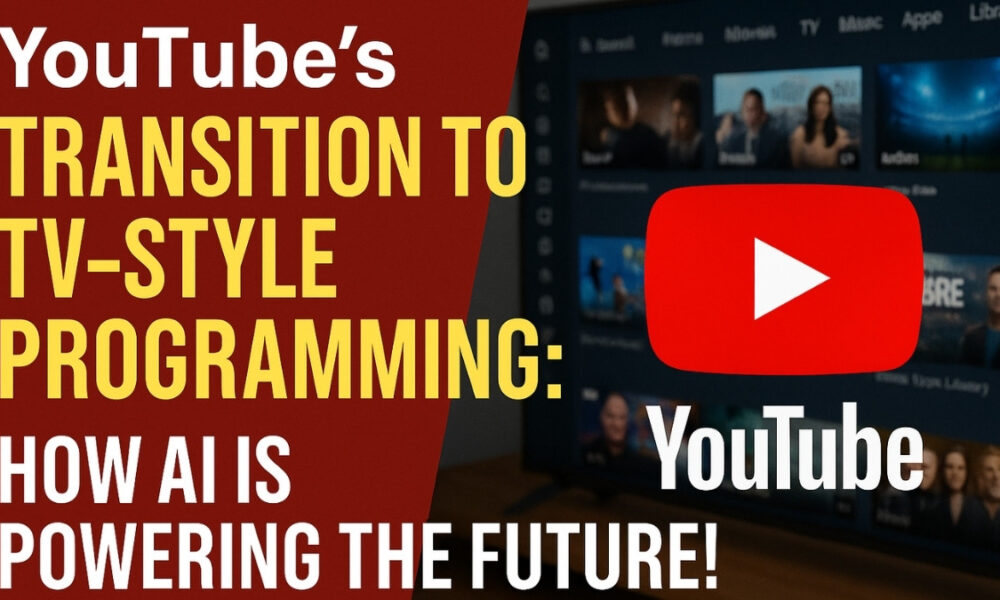Digital media
YouTube’s Transition to TV-Style Programming: How AI is Powering the Future!

YouTube, once dominated by short clips and user-generated content, is now positioning itself closer to a full-scale broadcasting platform. With the rise of streaming competitors and changing viewer behavior, YouTube is integrating artificial intelligence to deliver more professional, TV-style programming. This shift is not only redefining the platform for viewers but also opening new monetization and growth opportunities for creators and investors.
Why the Shift to TV-Style Content?
- Competition with Streaming Platforms: YouTube faces direct competition from Netflix, Hulu, Amazon Prime, and other streaming services. Offering TV-like content keeps audiences engaged.
- Longer Watch Times: Advertisers prefer longer-form content, and TV-style shows ensure better revenue per viewer.
- Professional Creators and Brands: More brands are using YouTube to distribute full episodes, documentaries, and live shows.
The Role of AI in YouTube’s New Strategy
- Personalized Recommendations: AI algorithms curate TV-like playlists and suggest long-form series, keeping viewers engaged.
- Automated Editing & Production Tools: AI assists creators with auto-editing, captioning, thumbnail generation, and even scriptwriting.
- AI-Driven Advertising: Smarter ad placement increases revenue and reduces user drop-off.
- Content Moderation and Compliance: AI helps maintain content quality and meet broadcasting standards.
Opportunities for Creators and Investors
- Monetization Expansion: Higher ad revenue from long-form content and brand sponsorships.
- AI-Powered Analytics: Detailed insights help creators optimize audience retention and earnings.
- Investor Appeal: YouTube’s growth strategy strengthens Alphabet’s market position, making it more attractive to investors focused on media tech.
Table: Platforms, Features, and Ideal For
| Platform / Feature | Key Capabilities | Ideal For |
|---|---|---|
| YouTube Studio with AI Tools | Automated editing, captions, and insights | Creators producing TV-style content |
| AI-Powered Recommendation Engine | Personalized long-form playlists | Viewers seeking curated TV-like experiences |
| AI Ad Targeting and Monetization | Smarter ad placement and higher revenue potential | Brands, advertisers, and investors |
| Live and Premieres with AI Support | Enhanced live shows and scheduled broadcasts | Broadcasters and professional content makers |
AI’s Role in YouTube’s New Era
- Advanced Recommendation Algorithms: AI curates longer playlists and TV-like series based on viewing history, improving retention and ad value.
- AI-Generated Metadata: Smart tagging, chaptering, and SEO optimization boost discoverability.
- Content Quality Enhancement: AI tools improve video resolution, stabilize shaky footage, and even create synthetic voices or visuals to enhance storytelling.
- Regulatory and Safety Compliance: AI ensures TV-like content meets guidelines and local broadcasting standards.
- Predictive Analytics for Creators: Data-driven insights help creators plan future episodes and optimize release schedules.
Opportunities for Different Stakeholders
- Creators: Access to AI editing, subtitles, analytics, and monetization insights helps creators compete with major studios.
- Advertisers: AI-powered targeting ensures ads reach relevant demographics, improving ROI.
- Investors: YouTube’s strategic push toward TV-style content signals growth in premium advertising, making it a stronger player in the streaming economy.
- Viewers: Improved curation and content quality make YouTube an attractive alternative to cable and OTT platforms.
Emerging Trends to Watch
- YouTube Originals 2.0: Expect more original productions, documentaries, and partnerships with TV networks.
- AI in Live Broadcasting: Real-time captions, translations, and audience analytics for live events and premieres.
- Creator-Led Channels: Independent creators will launch episodic series and mini-TV shows powered by AI assistance.
- Hybrid Revenue Models: Combining ads, sponsorships, memberships, and premium pay-per-view options.
AI-Driven Content Structuring and Personalization
- Dynamic Episode Sequencing: YouTube is experimenting with AI systems that dynamically reorder or bundle episodes based on viewer behavior, similar to TV networks programming prime-time slots.
- AI-Based Audience Segmentation: By leveraging AI, YouTube creates detailed audience profiles (age, interest, geography) to deliver hyper-personalized content streams.
AI-Powered Production and Editing Tools
- Virtual Studios: AI tools allow creators to use virtual backgrounds, motion graphics, and broadcast-style overlays without expensive hardware.
- Automated Multi-Language Dubbing: YouTube’s AI translation models are moving beyond subtitles, enabling real-time dubbing for global audiences.
- AI-Powered Scriptwriting and Ideation: Integrated AI assistants can suggest scripts, episode structures, and creative concepts, helping creators produce high-quality content faster.
Data-Driven Advertising and Monetization
- Contextual AI Advertising: Ads are automatically matched to video segments based on themes, emotions, and keywords, maximizing relevance.
- Predictive Revenue Models: AI forecasts ad performance and subscriber growth, allowing creators and investors to plan monetization strategies.
- Interactive AI-Enhanced Ads: Viewers can engage with ads through polls, clickable features, or personalized offers.
Compliance, Safety, and Ethics
- AI-Based Age Verification and Content Rating: YouTube is using AI to analyze video content for maturity levels, enhancing parental controls and advertiser safety.
- Ethical Content Moderation: AI detects harmful, misleading, or policy-violating material before publication, ensuring TV-like broadcast standards.
AI in Community Engagement
- AI-Powered Comment Moderation: Intelligent filtering reduces spam and toxicity, improving community trust.
- Creator-Viewer Interaction Tools: AI recommends live Q&A sessions, polls, and episodic cliffhangers based on audience engagement trends.